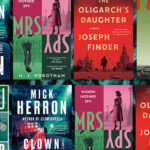
Reading Across America: Brooklyn's Tables of Contents
It's Never a Bad Idea to Mix Food and Literature
When I walked into Egg in Williamsburg alone for a reading series on a Wednesday night last fall, I didn’t know what to expect. The Brooklyn restaurant was outfitted normally—in the back, where we were gathering, tables that seat two to four people lined the sides of the room, and a large communal table ran down the middle. I surveyed the scene before choosing a seat on the side and had only been sitting for about a minute when a woman I didn’t know beckoned me to the communal table.
At the table, she asked me about myself and my experience with the reading series. I had none, and she said this was her second time. Soon after, another woman joined us, and she was a friend of the chef. None of us had read any of the books by the night’s readers—Angelica Baker, Will Chancellor, and James Hannaham—but by the end of the evening, the two women, who had just met, decided to start a book club to discuss the authors’ books. This is the spirit of Tables of Contents, a reading series curated by Egg’s chef Evan Hanczor that marries literature and food.
Curious about the origins of the series, I met up with Hanczor a few days later. In its current incarnation, he said, Tables of Contents began in October 2015 with authors Rebecca Dinerstein, Sophie McManus, and Alexandra Kleeman. Dinerstein, a friend of Hanczor’s, had recently published her novel The Sunlit Night, and the chef and partner offered Egg as a place to host a reading. After each author read, Hanczor led a Q&A with them. Since then, Tables of Contents events have largely followed that format. “For me, it was like, ‘Oh my God, I get to chat with awesome writers,’” Hanczor said. “This is what I envisioned myself doing when I was in school.”
Hanczor thinks the idea for Tables of Contents began to form when he was in college, reading The Sun Also Rises. “I was just captivated by the food in the book,” he said. His appreciation for the novel’s descriptions of food led him to create a lavish book-themed dinner event (also called Tables of Contents) in 2012. For these dinners, which are an annual collaboration with the Food Book Fair, Hanczor and his team create a five-course tasting menu, centered around a classic book; the menu for the To Kill a Mockingbird event included collard greens, crackling bread, and country ham.
After the event for Rebecca Dinerstein, Hanczor decided that there was room for both the Tables of Contents dinners and the Tables of Contents readings. For the readings, instead of a five-course tasting menu, Hanczor creates appetizer-like bites to pair with each author’s book. The events are known to sell out quickly, and the $10 tickets purchased through Eventbrite include an alcoholic drink, all of the night’s snacks, and a plate of biscuits that sits on every table.
*
Hanczor didn’t think he would end up in the food industry. In college, he studied English and Philosophy, thinking that he would be a poet. “I discovered it’s a lot easier to get people to eat something that I made than to read a poem I wrote,” he said with a laugh.
He didn’t always see food as being an important issue until he realized all the ways it impacts lives, from growing, policy, and access to sharing a special occasion with loved ones. He read books by Wendell Berry, Michael Pollan, and Anna Lappé and started figuring out how he could be involved in food. Even so, the pull toward writing was always there. As he weighed potential careers, he thought, “I really like cooking, I really like writing. If I want to write, I should just get a job I’m not interested in so I can do that mindlessly and write. Or I should just cook.” As a full-time chef, Tables of Contents has given him the opportunity to reconnect himself in the literary community.
Since 2015, Hanczor and his team have welcomed over 35 authors to Egg, including Kaitlyn Greenidge, Alexander Chee, Victor LaValle, Idra Novey, and Adam Gopnik, and some readers have made repeat appearances. Hanczor is conscious of how multiple factors play into each other at Tables of Contents events, from the texts and the menu to the food’s aroma and the background music played after each author’s reading.
Hanczor finds that Tables of Contents allows him to explore his culinary creativity in ways that are hard to replicate in a traditional restaurant setting. “When you cook food in a restaurant for customers, you have to cook food that’s delicious and comforting and makes them happy,” he said. “But when people are coming to this reading series, you can cook food that maybe is delicious, maybe is a little weird, maybe makes them happy, maybe makes them sad or uncomfortable.” For that reason, his favorite book and bite pairings tend to be darker, like lemon pudding for Sarah Gerard’s Sunshine State, inspired by an essay where Gerard’s grandmother is in hospice care, or a smushed cheese sandwich for a scene from James Hannaham’s novel Delicious Foods, where a person addicted to crack talks to someone while eating a sandwich.
“At the beginning of the dinners,” Hanczor said, “what I’ll say to people is that our real hope is that each element of the meal—the words and the food—amplifies and enhances the other one.” There is a dinner party vibe to the readings, as each event seats about 40 people, and the authors sit among those who come to hear them. During the first Tables of Contents I attended, I made small talk with Will Chancellor, who I only realized was one of the night’s authors when he got up to read.
“I like the way the walls of the traditional reading are broken down, because you end up just chatting with whoever’s around you,” Hanczor said. He believes that when the audience and readers sit together, it helps people experience the human side of authors in ways that don’t always happen when a writer reads from a podium in the front of a room. “We all have food-based lives,” he said, and he believes the interactive experience might offer a new way into reading the featured books.
Hanczor is inspired by varied ingredients and cultures when he cooks, but by bringing books into it, he said, “that’s like opening a whole new recipe book.” And it’s not just inspiring for him. “We’ve had authors say that they’ll definitely now be considering their food choices more carefully in their writing.”
If attendees don’t know any of the authors who are reading, the draw is still there. The joy exists in being able to meet the authors and hear their work, to sit and connect with other audience members, and to enjoy what Hanczor and his team have created. It’s not just a reading, but an experience.
In a city that can be so lonely, Tables of Contents is a welcoming space where you can go eat a little food, hear a little literature, and maybe leave with a sense that New York is more permeable than it seems.
Abigail Bereola
Abigail Bereola is a writer and currently the Books Editor at The Rumpus. Her work has appeared in GQ, The Paris Review Daily, Shondaland, and Broadly, among other publications, as well as on The Heart. She aims to be a socially conscious creative and is interested in multidisciplinary work centering around audio, film, and writing.



















